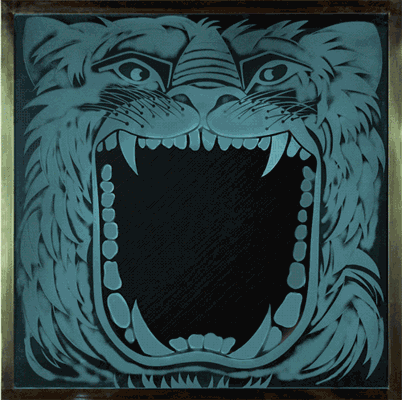MeRoar
1974 - mixed technique on mirror, 75x75x6 cm (LED internally lit)
Dedicated to Ivan Pavlov and the experiments he conducted on dogs.
(Further marginal references to ‘Id’, ‘Ego’ and ‘Superego’.)


The artist looks away after looking in the mirror, and a lion roars back at him. MeRoar, obviously a play on the word ‘mirror’, draws on the psychological importance of the morning ceremony. The psyche is reinforced as the attitude projected onto the mirror’s surface is thrown back upon the individual, who adjusts himself accordingly. Our presence in this world is always accompanied by a double - the image of ourselves that we project. Time spent in front of a mirror can be crucial in strengthening the personal traits which lead to ‘success’ (?), symbolized by the lion’s roar, a symbol of potency.
What matters in this case is not the object of the mirror itself, which is already full of meanings and references, but the process of ‘acting one's self’, and then reacting to this; to reflect oneself and see oneself as something other, because according to Pirandello’s eponymous novel: man is ‘one, no one and one hundred thousand’.
The mathematician René Thom asserts that language provides a mirror on the world where everything is interrelated, and in which a reaction must correspond to a flow of information. Neuroscience teaches us that the individual personality is nothing more than the ordering of life’s random events into a meaningful narrative. Lose sight of a strong narrative and one quite literally ‘loses the plot’ !
But luckily, humanity’s yarn-spinning capacity seems far from being exhausted !
"If a lion could speak, we could not understand him" ( Ludwig Wittgenstein )
Westminster hall - (Houses of Parliament)
"I was not the lion, but it fell to me to give the lion's roar" (Winston Churchill - 30 november 1954)


